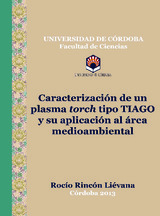Mostrar el registro sencillo del ítem
Caracterización de un plasma torch tipo TIAGO y su aplicación al área medioambiental
| dc.contributor.advisor | Calzada Canalejo, María Dolores | |
| dc.contributor.advisor | Sáez Cano, Manuel F. | |
| dc.contributor.author | Rincón, Rocío | |
| dc.date.accessioned | 2013-09-19T12:43:02Z | |
| dc.date.available | 2013-09-19T12:43:02Z | |
| dc.date.issued | 2013 | |
| dc.identifier.uri | http://hdl.handle.net/10396/10945 | |
| dc.description.abstract | Plasma is a gas partially ionized which is considered the fourth state of matter. It consists of electrons, ions and neutrals in fundamental and excited states which make it a chemically active media. Within plasma, reactions (which are not allowed to take place in other media) can be achieved. In addition, depending on the way plasmas are created and their working power, low or very high temperatures can be generated. This wide temperature range enables many applications for plasmas technologies such as deposition of surface coatings, chemical analysis, nanomaterial synthesis, sterilization, food preservation¿ However, apart from these applications, plasma technology has been devoted to solve some environmental problems. Global warming is one of the most worrisome problems that the scientific community should face up to. Global warming is related to the rise in the average temperature of Earth¿s atmosphere and oceans which is caused by the increasing concentration of greenhouse gases produced by human activities such as the burning of fossil fuels. Plasma technology not only has been successfully utilized to eliminate some of the greenhouse gases or to destroy volatile organic waste, but also to generate hydrogen, which is considered as an alternative fuel to fossil ones. Due to a decrease of fossil fuels reserves and the greenhouse effect, energy industry is devoting considerable resources and expertise to find other energy resources, and hydrogen is a promising option for the energy supply of fuel cells. Nevertheless, only two major technologies, which are catalytic route through the water gas shift reaction and electrolytic decomposition of water, have been developed at large scale. However, the use of catalysts involves some shortcomings due to some catalyst lifetime. Therefore, a more economic and environmental friendly alternative, such as plasma technology, is being researched to avoid some conventional hydrogen production drawbacks. Recently, there has been a growing interest in using microwave plasmas sustained at atmospheric pressure to decompose alcohols or hydrocarbons as enriched-hydrogen sources. Their low-power operation requirements, high stability, reproducibility and non-thermal properties makes them suitable for this purpose. Microwave torches are noteworthy microwave plasma sources which are well-known thanks to their higher tolerance to sample injection and the possibility to deliver higher power amounts to the discharge in contrast to other microwave devices. TIAGO torch (Torche à Injection Axiale sur Guide D¿Ondes) [1] has been developed as an improvement of the well-studied TIA torch (Torche à Injection Axiale) [2]. All these characteristics jointly to atmospheric pressure conditions make TIAGO torch an excellent candidate to industrial implementation. Notwithstanding Prof. M. Moisan and co-workers published in 2001 the design of TIAGO torch [1], no research concerning the kind of plasmas produced by it or its use in applications has been carried out. Thus the essential aim of the present Thesis has been the study of plasmas sustained with TIAGO torch and their use application for solving some environmental issues. For this reason, in the present work, both basic and practical researches have been joined. On one hand, a complete characterization of plasmas produced by the TIAGO torch (fundamental research) was necessary prior to exploring its application capabilities. On the other hand, from the knowledge extracted in the first step of this research, the production of hydrogen from ethanol decomposition was developed (applied research). Hence, the objectives pursued in this Thesis have been: To identify the experimental conditions (flows and input powers used to sustain the discharge) needed to keep the discharge stable and to describe the morphology, kinetics and thermodynamic equilibrium degree of the Ar discharges generated with TIAGO torch. To assess the capability of Ar plasmas to decompose ethanol molecules introduced into the discharge and to study the amount of hydrogen generated in the decomposition process as well as to identify other gases produced in the gas exhaust. | en |
| dc.format.mimetype | application/pdf | es_ES |
| dc.language.iso | spa | es_ES |
| dc.publisher | Universidad de Córdoba, Servicio de Publicaciones | es_ES |
| dc.rights | https://creativecommons.org/licenses/by-nc-nd/4.0/ | es_ES |
| dc.subject | Plasma de microondas inducido (MIP) | es_ES |
| dc.subject | Termodinámica | es_ES |
| dc.subject | Espectroscopía de emisión | es_ES |
| dc.subject | Espectroscopía de masas | es_ES |
| dc.subject | Antorcha TIAGO | es_ES |
| dc.title | Caracterización de un plasma torch tipo TIAGO y su aplicación al área medioambiental | es_ES |
| dc.type | info:eu-repo/semantics/doctoralThesis | es_ES |
| dc.rights.accessRights | info:eu-repo/semantics/openAccess | es_ES |

